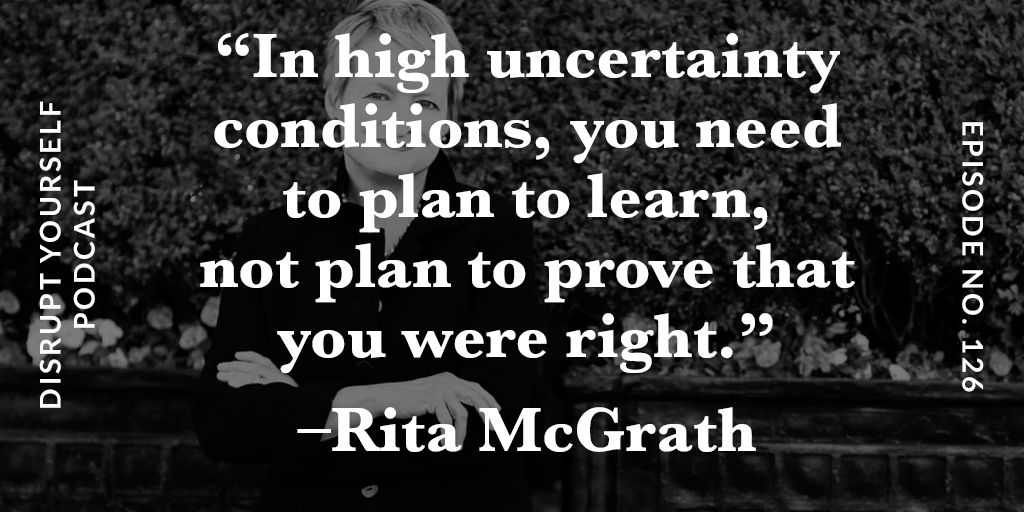When the Wright brothers completed the first sustained manned flight it was a pivotal moment in history. Travel, commerce, logistics, and world relations would forever be impacted by those 12 seconds in North Carolina, but to the people living at that time it was almost impossible to imagine or consider relevant to their lives. It took almost four years for the Wrights to receive any significant newspaper coverage, and it is only in retrospect that we can see how important those 12 seconds really were. It was an inflection point—the moment when everything changed.
My guest today is Rita McGrath, and she literally wrote the book on inflection points for businesses. These moments when the assumptions about your business change or become irrelevant are not always easy to spot, but, as Rita explains, they can make or break you.
“[S]trategic inflection points…cause huge, enormous changes, but not right away. And that’s the strategic window of opportunity because if you can spot it early and decide what to do about it, it can actually take your business to wonderful new heights.”
Together with Ian McMillan, her research on discovery driven planning has had a significant impact on the way modern businesses view strategy and innovation. Twenty years ago, they conducted a series of studies into corporate flops where large ideas from seemingly successful companies ended in complete disaster. Rita and Ian began noticing commonalities between the different case studies, which in turn led to a realization of how to avoid these failures.

Their work has been featured in The Lean Start Up, as well as my own pantheon of publications—Build an A-Team, Disrupt Yourself, and Dare, Dream, Do. Clayton Christensen referred to their ideas as some of the most important management ideas developed, and I am honored to have Rita on the podcast with me!
There is so much to unpack here. Rita gives some great insights into how organizations can plan for the future, as well as how they can avoid the pitfalls of short-sightedness. Join us as we discuss why big ideas sometimes fail; how to spot inflection points; and what may be around the corner for American businesses.
Listen in the player above, or download the episode on Apple Podcasts. Let us know in the comments what you think, and what you see around the corner!
Takeaways from this episode:
- Rita and Ian McMillan examined why big new corporate ideas fail despite having massive support from the company behind them. They discovered common patterns that led to the disasters:
- Untested assumptions taken as facts
- Few opportunities for low-commitment testing
- Leaders personally associated with the success of the project and emotionally committed
- Money up front
- Planning for highly uncertain business as though there is a “rich platform of experience” backing it up
- In high uncertainty situations, it is important to “plan to learn.” Engage in discovery driven planning:
- Consider what would have to be successful.
- Ask yourself, Am I realistic?
- What do you have to do? (How many sales calls, how many responses?) Write these down, as you may be making assumptions.
- Plan to the next checkpoint
- Today, those with “competitive advantage” have it for a much shorter period of time than in generations prior. Never assume that it will last forever.
- Strategic inflection points cause enormous changes, but they often come quietly, unnoticed by most of the world. Even when the Wright brothers were inventing manned flight, many people ignored what they were doing. It took four years before newspapers took the innovation seriously.
- Inflection points to watch: transitioning from traditional retail supply chains to direct-to-consumer models; A.I. technology (who is training the machines?); the internet of things and who owns data.
- Twenty years ago, “innovation” was a side show to strategies for businesses. Now, it is one of the main features.
- Organizations need to be consistent with their vision, think about what will drive engagement, and willing to plan for the 4th quarter four years from now (not the fourth quarter of this year).
- To spot inflection points, pay attention to these indicators:
- Lagging indicators: things you can’t change, because they have already happened/are the result of something that has already been done. An outcome.
- Current indicators: things that tell you where you are, what is happening right now.
- Leading indicators: something that gives you information about what might happen in the future. Tend to be qualitative, not quantifiable.
- Take on the challenge of imagination: think of two future uncertainties and juxtapose them against each other. Articulate specific future events that could happen in those scenarios. Work backwards to see what would need to happen for that future to be a reality. Look for those indicators going forward.
- If you are a leader in your organization, ask yourself how often you personally get out to the “edges.” Get fresh information that hasn’t been sent through numerous channels to get to you. Look for diversity of thought from those whose experience is different from yourself and those immediately surrounding you.
- There will come a moment where you will need to decide between leaning into a change (using the inflection point to catapult you forward), or to retreat and double down on the “old way” of doing things.
Links Mentioned in this Episode:
- Rita McGrath – Website | Twitter | LinkedIn
- Seeing Around Corners: How to Spot Inflection Points in Business Before They Happen by Rita McGrath
- Dare, Dream, Do: Remarkable Things Happen When You Dare to Dream by Whitney Johnson
- Disrupt Yourself, With a New Introduction: Master Relentless Change and Speed Up Your Learning Curve by Whitney Johnson
- Build an A-Team: Play to Their Strengths and Lead Them Up the Learning Curve by Whitney Johnson
- Disrupt Yourself Podcast – Episode 48: Eric Ries
- The End of Competitive Advantage: How to Keep Your Strategy Moving as Fast as Your Business by Rita McGrath
- The Fearless Organization: Creating Psychological Safety in the Workplace for Learning, Innovation, and Growth by Amy Edmonson

